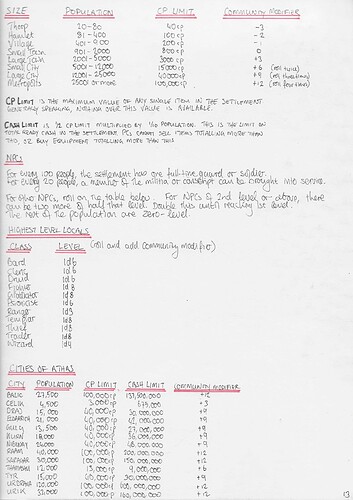Dear Athasians,
I am looking for opinions on how much wealth some people or communities can or should have, in gp, sp, cp and bits. Maybe you remember some sources or can make an guess based on prices, everything is welcomed. The Tribe of One Trilogy went too far with a 100.000 gp hired sellsword imo but i might be wrong.
Wealth of a…
City-State
Dwarf Village
Slave Tribe
Altaruk
Fort
Major Trading House
Minor Trading House
Veiled Alliance
etc.
I like a “metal is rare, even with coins setting” so I would go with:
City-State (Population 12.000) avg. 1 Mill. gp, 10 Mill. sp, 50 Mill. cp, 200 Mill. bits
Dwarf Village (Population 1.000) 10 gp, 1.000 sp, 5.000 cp, 8.000 bits
Slave Tribe (Population 100) 30 sp, 400 cp, 1.000 bits
Altaruk (Population 1.200) 60 gp, 2.000 sp, 8.000 cp, 12.000 bits
Fort (Population 60) 60 sp, 600 cp, 1.200 bits
Major Trading House 100.000 gp, 600.000 sp, 3 Mill. cp, 10 Mill. bits
Minor Trading House 1.000 gp, 6.000 sp, 300.000 cp, 1 Mill. bits
Veiled Alliance 100 gp, 1.000 sp, 10.000 cp, 50.000 bits
But I’m not very sure about such a approach.
Thanks to anyone replying.
May your waterskin never run dry.
